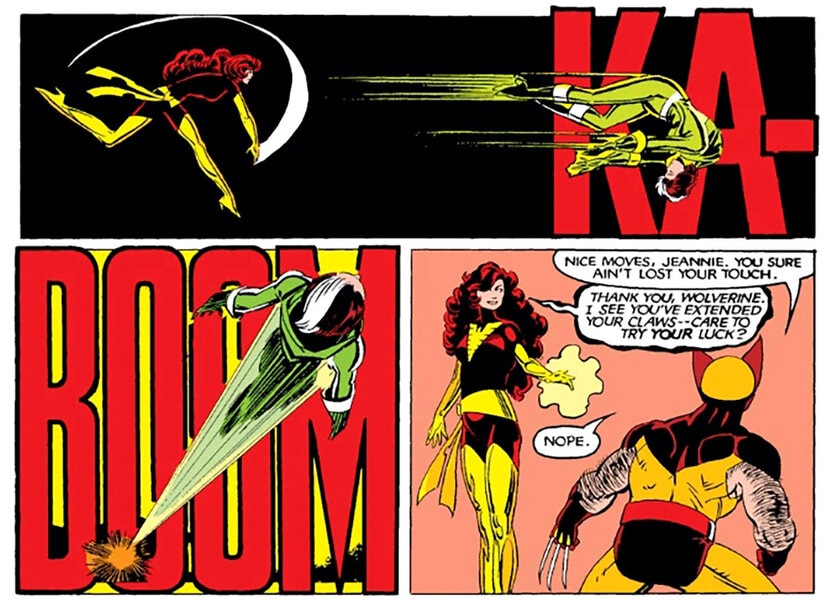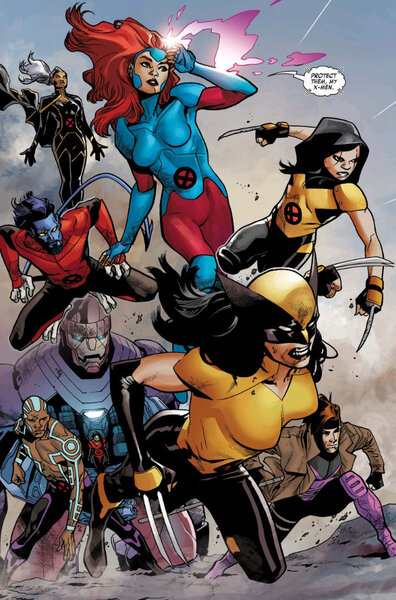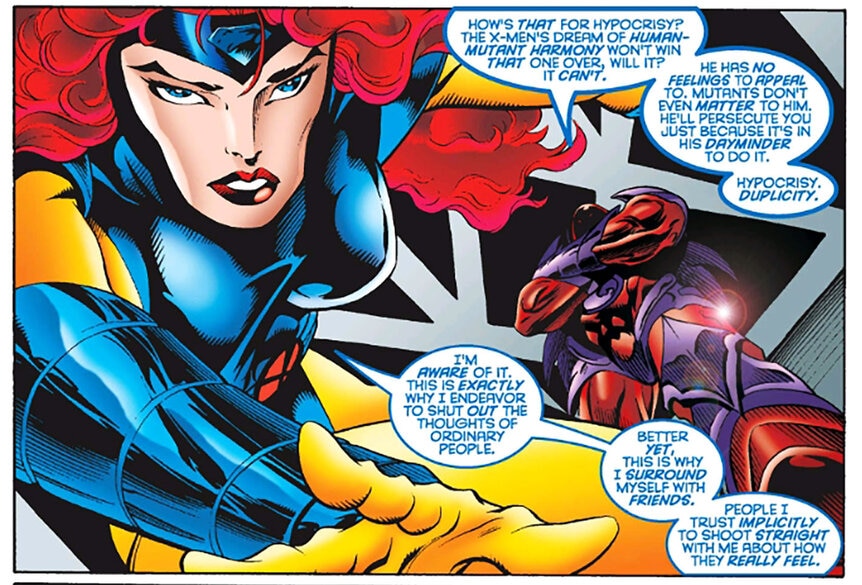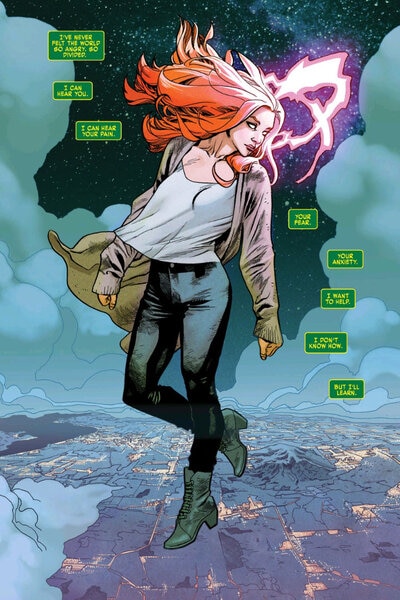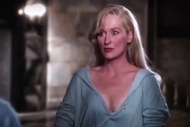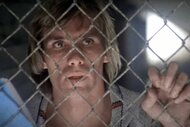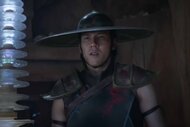Create a free profile to get unlimited access to exclusive videos, sweepstakes, and more!
Where are all the great Jean Grey stories?
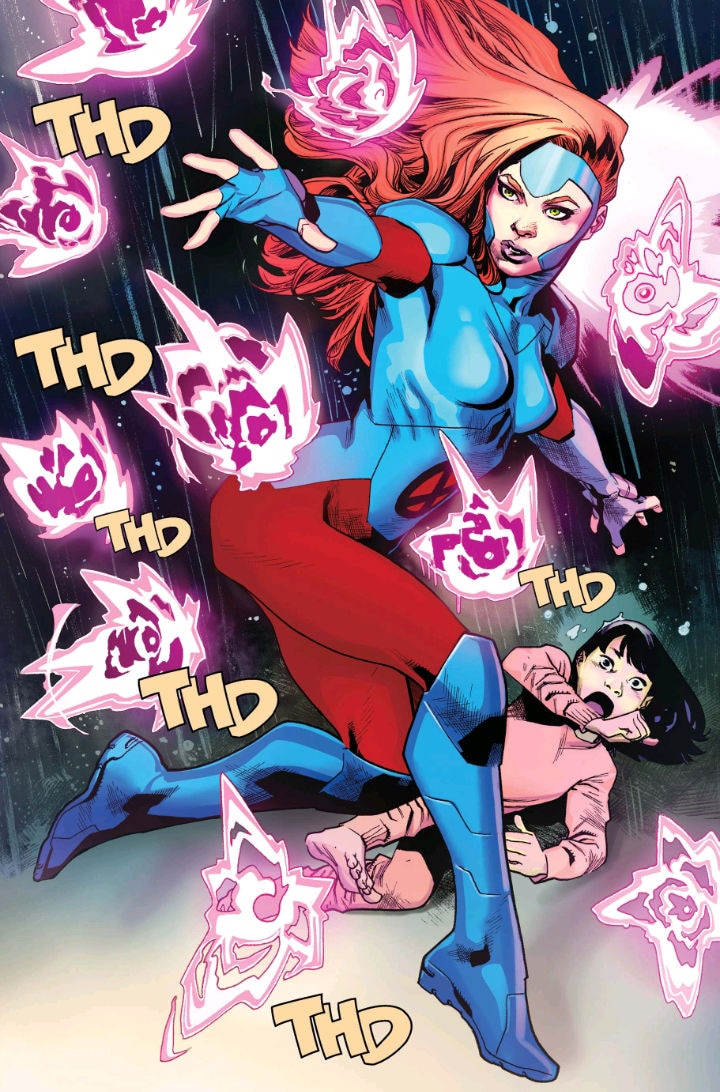
Jean Grey is easily one of the most misunderstood characters in all of genre history, and it’s pretty easy to see why that is. Her first many years were spent as “the girl” of the X-Men during the Silver Age, then when she finally got a truly iconic storyline with the Phoenix Saga, she was later retconned right back out of it. References and reboots of that story have been occurring and repeating themselves for decades at this point, and so for potential new fans of Jean Grey, there hasn’t been a whole lot to hang onto when it comes to definitive character arcs.
In short, this is a character who is best known for dying, repeatedly, and, as such, life hasn’t been too terribly kind to our friend Jean Elaine Grey. That said, she has had so many brushes with greatness that her longtime fans are used to asking the question, “Where are all the great Jean Grey stories?”
Well, there are a few. But we’re going to have to dig for a minute.
Humble BeginningsWhat can one say about the Silver Age of comics? It gave us some of our favorite characters in the history of the genre, but it was also a terrible place for those female characters to exist. During the early days of the X-Men, Jean wasn’t especially well-characterized and she often seemed to exist just to give the male characters someone to condescend to and flirt with. She and Scott crushed out on each other for the better part of 60 issues before the series was canceled due to poor sales and went into reprints.
The X-Men underwent their first major status quo change when they were reimagined for Giant-Sized X-Men, in which a new team of mutants was assembled to go save the original five (well, four of the original five, as Cyclops had escaped and was there to lend the new team a hand). This whole story was retconned to be much more confusing, and to make Xavier into the least sympathetic character ever to exist, with the Deadly Genesis story. Fortunately, that doesn’t play a huge part in Jean Grey’s trajectory.
It is worth noting, however, that Charles Xavier is almost definitely a villain in Jean’s life via most interpretations of the story. In the Silver Age, he was shown dismissing her while simultaneously lusting after her despite being her mentor and father figure. He failed her completely during the Phoenix Saga by being self-involved to the point of hubris, and in the X-Men films, we discover that he literally caused a break in her personality because he was so intimidated by the idea that she might become too powerful for him to control. This guy was not a great mentor to most of the X-Men, but when it comes to Jean and Scott, he failed them on a truly profound level. On the other hand, Jean usually refuses to take any nonsense from the Professor, and it’s clear, at least in her adulthood, that she is one of the few people he respects as an equal.
That Darn Phoenix
Of course, the Phoenix Saga changed everything for the X-Men in general, but for none quite so much as Jean. Seemingly killed while saving the rest of the team in space, Jean was supposedly possessed by a cosmic entity known as the Phoenix. The X-Men have adventures with her but ultimately she was corrupted by the power she holds and slowly loses her personality to the Phoenix. Destroying an entire inhabited planet in her quest for sustenance, Jean regained control, but was wracked with guilt over her actions, and committed suicide while on the moon. This sent Scott reeling, and he ended up leaving the X-Men for a time.
When Scott returned, he had his fiance Madelyne Pryor with him, who was a clone of Jean, unbeknownst to the X-Men. They had a child together, but when it was discovered that Jean had actually been in a cocoon at the bottom of Jamaica Bay throughout the entirety of the Phoenix Saga, Scott had a mental break and left Madelyne and their child behind to find Jean. Though they were reunited, they both experienced extreme hardship adjusting to everything that had happened in their lives. Madelyne went missing, then resurfaced as the Goblin Queen and tried to murder her own child in Medea-like revenge against Scott. Jean and Madelyne had a showdown with one another, Jean emerged triumphant, and she and Scott tried to raise his and Madelyne’s son together until he came down with a deadly disease and had to be taken far into the future to be saved by advanced tech, meaning that he would be lost to them forever.
From Inferno to Resurrection
Later, it was revealed that the mutant Cable was Cyclops’ son Nathan all grown up, having lived in a dystopian future and battled the villain Apocalypse for much of his life. Cable also had a clone named Stryfe. All of this was discovered when Stryfe kidnapped Jean and Scott in an act of poorly planned vengeance. For their part, Jean and Scott were a little confused to say the least, but they both eventually went on to share emotional moments with Cable, most significantly when they traveled into the future pretty much just to hang out with him in The Adventures of Cyclops and Phoenix.
Scott and Jean were eventually married, and that lasted until New X-Men in which she and Cyclops went their separate ways as he began an affair with Emma Frost. Meanwhile, Jean was sent into the sun to die, barely survived, returned to Earth, and was ultimately killed. She spent most of the 2000s dead, but not forgotten, as her teen self came to the present and spent years interacting with the other X-Men and developing in unique ways that seemed to set her on a different course than the original Jean Grey. Later, teen Jean was sent back to the past when Jean came back from the dead, seemingly separate from the Phoenix and leading her own team of X-Men.
As For Television
Another thing standing in Jean’s way is that a lot of fans were introduced to her with the ‘90s animated series, which habitually underused and reduced her role in the narrative. Though there were hints of an attraction between Jean and Logan in the comic, this show is essentially where the love triangle between Jean, Wolverine, and Cyclops grew to be a character-defining subplot. At the cost of Jean’s personal development, the focus was removed from her and placed onto the feud between Logan and Scott.
Meanwhile, in X-Men: Evolution, we have what is likely the most favorable and interesting of the animated and film takes on the character. This Jean is mature and responsible and takes leadership easily. We never see her turn into Phoenix, and more emphasis is given to her relationship with Scott. Evolution is fairly underrated overall, and at the time it was likely the best depiction of Jean.
The X-Men live-action films, meanwhile, are a little trickier. We are initially introduced to Jean as “Doctor” Grey, which gives us a compelling glimpse of what Jean might have become without the Phoenix, but we see very little storyline around that, and she is again rapidly reduced to being the object of Logan’s lust. The mental health connotations of Phoenix as a split in Jean’s personality can seem reductive, both to the character herself and for people who suffer from mental health issues in real time, for whom life is significantly more complex and not generally assisted by depictions of a “hysterical” woman who dies multiple times throughout the franchise.
The challenge of the X-Men movies, in general, is that they are forced to find a way to fit massive amounts of continuity into a relatively very small space. Generally speaking, it would take longer than two hours to read all of the build-up for the ultimate final moments of the Dark Phoenix Saga. As a result, what we’re usually getting when we watch these films is a lot of character beats that took years to build delivered in an instant. The scene with Jean and Scott on the Mesa, with Jean taking off his visor and telepathically holding back his eye blasts, was meaningful for many reasons that can’t be delivered in a two-minute long scene. Your mileage will vary on the X-Men films, and there is certainly a defense to be made for the scriptwriters doing what they could within their limitations, but the fact remains that these moments are impactful in the comic in a way that they simply aren’t in the movies.
When Jean and Scott meet on the Mesa, she and Scott had spent years of storytelling believing the other to be dead. When they were reunited, Jean had changed significantly, having spent time as a single woman in NYC, rooming with Misty Knight and having her own adventures there. The manipulator and illusionist Jason Wyngarde had seduced Jean. He had seen her become Dark Phoenix. She had struggled to regain control of her power in the deep recesses of space. More importantly, Scott had watched Jean going from someone that needed his protection to be the most powerful woman on Earth. By taking off his visor, they were reaffirming their commitment to stick together, and that is why it became one of the most definitive moments in their relationship for years to come. This could not be conveyed in a movie that spent less than five minutes combined on their interactions, admittedly through no fault of the scripters or the actors involved. It is entirely possible to watch this scene and enjoy it or to take a new exciting meaning from it, yet it remains a very different character beat from comic to film. This is even further complicated by the fact that Jean and the Phoenix are one and the same in the animated series and in the films, but not in the comics.
So Here’s Where You’re Going To Want To Start Your Reading List
So, where are the great Jean Grey stories? There was a reimagining of the Silver Age with X-Men: Season One that gave us a new glimpse of what the original run of the series might have looked like if Jean had an active role and a more fleshed out and consistent personality. Of course, the Phoenix Saga and the Dark Phoenix Saga are both beloved stories, but the build-up to them is equally interesting, starting as far back as when Claremont took up the series.
The early days of X-Factor can be a bit grating due to the constant influx of completely avoidable drama, but the Inferno storyline sees Jean Grey merge her persona with that of Madelyne Pryor’s as well as the Phoenix, creating a whole identity that saw us through several years. Jean focused stories were more sparse after that, but she threw down with Sabretooth in X-Men #28, then got married to Cyclops in #30 after years of turmoil, death, strife, and Stryfe. The Adventures of Cyclops and Phoenix mini-series saw her and Scott travel to the distant future, and it’s a fascinating epic for the couple as well as for Cable, who was finally given depth after a stint as a one-dimensional tough guy.
The Onslaught crossover is notoriously rough but X-Men #53 focuses in on Jean Grey and what her inner world is like, and it was one of the only times we saw Jean without Scott or the rest of the X-Men during this time period. The Grant Morrison run on New X-Men is a little uneven in its treatment of its characters, but it did give us a definitive Emma Frost, and the feud between Emma and Jean as Emma begins her relationship with Scott and Jean is pushed to the limits and dies is a major part of her characterization in the early 2000s.After New X-Men, Jean Grey stayed in the realm of the dead for some time, but her teen self was brought into the present with the rest of the original X-Men. This was a bizarre move that ended up being a lot more interesting than initially expected, and two highlights for this time period and this version of Jean are The Trial of Jean Grey, in which the X-Men and the Guardians of the Galaxy team up to exonerate Jean in deep space while she evolves her powers beyond what was previously imagined. This story was interesting because it showed us a glimpse of how much had truly been taken from Jean when she became Phoenix, and how the fears of Scott and the Professor had led her to subdue and repress her own power. Following that, the Jean Grey series that saw the foresaw the return of adult Jean also showed us the younger Jean interacting with the greater Marvel universe in a way that had never really happened before.
Finally, X-Men: Red only just wrapped, and it stands apart from all these stories in that it gives us a Jean Grey who is the head of her own team of X-Men. After years of watching this character be misunderstood, underused, sold short, taken advantage of, suppressed, repressed, and repeatedly traumatized, it was pretty great just to see Jean take a leadership role for once rather than collapsing again in flames, and establish herself as a character for readers who had only ever known her as the object of Scott and Logan’s combative affections.
